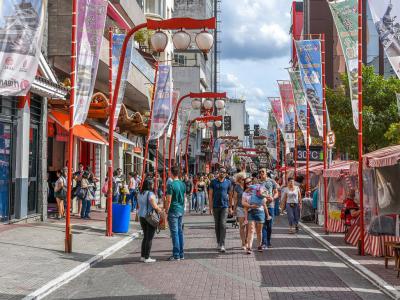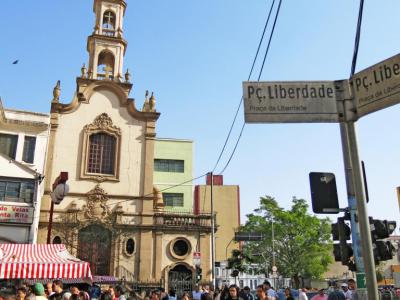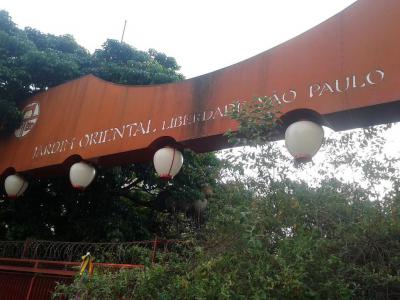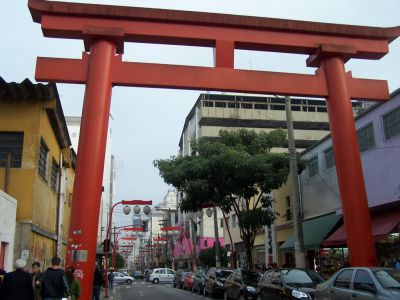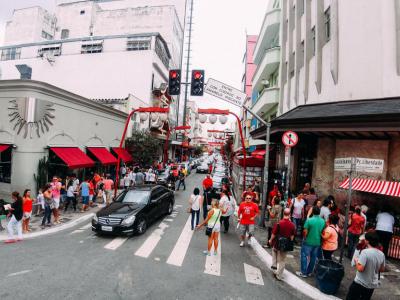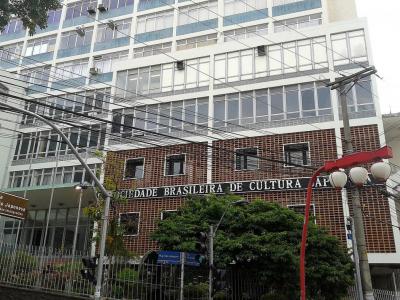Japantown Walking Tour (Self Guided), Sao Paulo
Home to the world's largest ethnic Japanese community outside Japan, the Sao Paulo district of Liberdade entices tourists with its Asian-inspired influences present everywhere: restaurants, shops, decor, markets, etc.
Up until the late 19th century, the area was known as Campo da Forca (Field of the Gallows) as the one reserved for the execution of slaves and convicts – for whom the only way to liberty was death. The hangings were carried out until 1891 in Largo da Forca (Gallows Square), the public square now known as Praça da Liberdade (Liberty Square). Igreja da Santa Cruz das Almas dos Enforcados (Church of the Holy Cross of the Souls of the Hanged), prominently located to the south of the square, commemorates the dead of Campo da Forca.
The Japanese presence in the neighborhood began in 1912. As of 1974 the entrance to Liberdade has been marked by a nine-meter tall red Torii (a characteristic arch marking the entrance to Shinto Shrines). This towering structure, situated on Rua Galvão Bueno (Galvão Bueno Street), is a distinctive representation of the neighborhood. People from all over the world, as well as other parts of Brazil, are often seen mingling with the Japanese housewives doing grocery shopping on Galvão Bueno and the businessmen looking for some low-priced Asian food for lunch.
As of recently, sizable populations of Chinese and Koreans have also inhabited Liberdade. Nowadays, the area is a popular tourist destination and a meeting spot for those interested in Asian (mainly Japanese) culture.
If you are suchlike and would like to explore the most popular attractions of Liberdade on your own, take this self-guided walking tour.
Up until the late 19th century, the area was known as Campo da Forca (Field of the Gallows) as the one reserved for the execution of slaves and convicts – for whom the only way to liberty was death. The hangings were carried out until 1891 in Largo da Forca (Gallows Square), the public square now known as Praça da Liberdade (Liberty Square). Igreja da Santa Cruz das Almas dos Enforcados (Church of the Holy Cross of the Souls of the Hanged), prominently located to the south of the square, commemorates the dead of Campo da Forca.
The Japanese presence in the neighborhood began in 1912. As of 1974 the entrance to Liberdade has been marked by a nine-meter tall red Torii (a characteristic arch marking the entrance to Shinto Shrines). This towering structure, situated on Rua Galvão Bueno (Galvão Bueno Street), is a distinctive representation of the neighborhood. People from all over the world, as well as other parts of Brazil, are often seen mingling with the Japanese housewives doing grocery shopping on Galvão Bueno and the businessmen looking for some low-priced Asian food for lunch.
As of recently, sizable populations of Chinese and Koreans have also inhabited Liberdade. Nowadays, the area is a popular tourist destination and a meeting spot for those interested in Asian (mainly Japanese) culture.
If you are suchlike and would like to explore the most popular attractions of Liberdade on your own, take this self-guided walking tour.
How it works: Download the app "GPSmyCity: Walks in 1K+ Cities" from Apple App Store or Google Play Store to your mobile phone or tablet. The app turns your mobile device into a personal tour guide and its built-in GPS navigation functions guide you from one tour stop to next. The app works offline, so no data plan is needed when traveling abroad.
Japantown Walking Tour Map
Guide Name: Japantown Walking Tour
Guide Location: Brazil » Sao Paulo (See other walking tours in Sao Paulo)
Guide Type: Self-guided Walking Tour (Sightseeing)
# of Attractions: 6
Tour Duration: 1 Hour(s)
Travel Distance: 0.8 Km or 0.5 Miles
Author: vickyc
Sight(s) Featured in This Guide:
Guide Location: Brazil » Sao Paulo (See other walking tours in Sao Paulo)
Guide Type: Self-guided Walking Tour (Sightseeing)
# of Attractions: 6
Tour Duration: 1 Hour(s)
Travel Distance: 0.8 Km or 0.5 Miles
Author: vickyc
Sight(s) Featured in This Guide:
- Praça da Liberdade (Liberty Square)
- Igreja Santa Cruz das Almas dos Enforcados (Church of The Holy Cross of the Souls of the Hanged)
- Oriental Garden
- Monumental Torii
- Galvão Bueno Street
- Museum of the Japanese Immigration
1) Praça da Liberdade (Liberty Square)
The Liberty Square was known as Largo da Forca. In 1831, with the abdication of Emperor Pedro I of Brazil , the then Legal Course Fountain was named as "Fonte da Liberdade". This name, over time, started to designate the entire neighborhood around it.
Until the arrival of Japanese and Chinese immigrants, it housed bars and cinemas. After the arrival of immigrants, the Liberdade neighborhood was customized according to the culture of its new inhabitants, including the square, which gained oriental lighting, oriental temples and space to celebrate the Chinese New Year.
On weekends the Square houses The Liberdade Street Fair. This popular open air market began in 1975 and operates near the Liberdade Metro station. There is a number of attractions, festivals and other artistic events that occur all year along at the market.
The street market was created to emphasize all kind of handicraft works and artisanal wares from the Asian immigrants. In recent years artisans of other nationalities have begun selling their crafts at the market. These newcomers to the Street Fair are from Northeastern Brazil, India, and Taiwan. They sell candles, toiletries, leather products, sculptures and so on.
Booths selling traditional Asian foods like yakisoba and gyoza are common.
Until the arrival of Japanese and Chinese immigrants, it housed bars and cinemas. After the arrival of immigrants, the Liberdade neighborhood was customized according to the culture of its new inhabitants, including the square, which gained oriental lighting, oriental temples and space to celebrate the Chinese New Year.
On weekends the Square houses The Liberdade Street Fair. This popular open air market began in 1975 and operates near the Liberdade Metro station. There is a number of attractions, festivals and other artistic events that occur all year along at the market.
The street market was created to emphasize all kind of handicraft works and artisanal wares from the Asian immigrants. In recent years artisans of other nationalities have begun selling their crafts at the market. These newcomers to the Street Fair are from Northeastern Brazil, India, and Taiwan. They sell candles, toiletries, leather products, sculptures and so on.
Booths selling traditional Asian foods like yakisoba and gyoza are common.
2) Igreja Santa Cruz das Almas dos Enforcados (Church of The Holy Cross of the Souls of the Hanged)
This church was built on the site of an old cross that honored an executed soldier, Francisco José das Chagas. Francisco José das Chagas was accused of being part of a revolt against the battalion commanders, seeking lost wages. Wages due to soldiers were often unpaid for months and years. He was condemned and executed on September 20, 1821. During the execution, the gallows rope broke twice, and the authorities completed the execution by beating Francisco José das Chagas to death.
The locals who watched the execution begged for mercy, which was not given. The twice-broken gallows rope seemed to speak of a divine sign of das Chagas's innocence. Local Catholics installed the cross as a tribute to das Chagas.
In 1887, the Holy Cross of the Hanging Church was built. The church was renovated in 1958, and the tower was added. The interior features an ornately painted nave, gilded accents, and a stunning chandelier.
The locals who watched the execution begged for mercy, which was not given. The twice-broken gallows rope seemed to speak of a divine sign of das Chagas's innocence. Local Catholics installed the cross as a tribute to das Chagas.
In 1887, the Holy Cross of the Hanging Church was built. The church was renovated in 1958, and the tower was added. The interior features an ornately painted nave, gilded accents, and a stunning chandelier.
3) Oriental Garden
Oriental Garden of Liberdade (Jardim Oriental Liberdade) is a charming public park located in the vibrant city of Sao Paulo. Situated in the Liberdade neighborhood, which is known for its rich Japanese heritage and culture, the garden serves as a beautiful oasis and a symbol of the strong ties between Brazil and Japan.
The park was inaugurated in 1995 as a tribute to the Japanese community in Sao Paulo, which is one of the largest outside of Japan. Its design draws inspiration from traditional Japanese gardens, incorporating elements of harmony, serenity, and natural beauty. The meticulous attention to detail and the combination of flora, water features, and architectural elements create a tranquil and authentic Japanese atmosphere.
As visitors enter Jardim Oriental Liberdade, they are greeted by a majestic torii gate, a traditional Japanese entranceway, marking the transition from the bustling streets of Sao Paulo to a peaceful retreat. The path meanders through a meticulously landscaped garden, offering a variety of ornamental plants, carefully pruned bonsai trees, and vibrant flowers that showcase the changing seasons.
One of the highlights of the garden is its picturesque pond, which is home to colorful koi fish and adorned with elegant bridges and stepping stones. The sound of trickling water from small waterfalls and fountains adds to the park's tranquility, creating a soothing and serene environment for visitors to unwind and connect with nature.
The park was inaugurated in 1995 as a tribute to the Japanese community in Sao Paulo, which is one of the largest outside of Japan. Its design draws inspiration from traditional Japanese gardens, incorporating elements of harmony, serenity, and natural beauty. The meticulous attention to detail and the combination of flora, water features, and architectural elements create a tranquil and authentic Japanese atmosphere.
As visitors enter Jardim Oriental Liberdade, they are greeted by a majestic torii gate, a traditional Japanese entranceway, marking the transition from the bustling streets of Sao Paulo to a peaceful retreat. The path meanders through a meticulously landscaped garden, offering a variety of ornamental plants, carefully pruned bonsai trees, and vibrant flowers that showcase the changing seasons.
One of the highlights of the garden is its picturesque pond, which is home to colorful koi fish and adorned with elegant bridges and stepping stones. The sound of trickling water from small waterfalls and fountains adds to the park's tranquility, creating a soothing and serene environment for visitors to unwind and connect with nature.
4) Monumental Torii
Since 1974, the entrance to the Liberdade district has been adorned with a striking nine-meter-tall Red Torii. This iconic arch, commonly found at the entrance of Shinto Shrines, comprises two vertical posts or pillars and a top crosspiece that typically bends inward in the middle. Located on Galvão Bueno Street, this towering structure serves as a distinct symbol of the neighborhood.
During the 1970s, Liberdade became connected to the São Paulo subway network, paving the way for increased commercial activity in the area. Today, thousands of São Paulo residents gather at the public square in Liberdade every Sunday to explore the weekly fair and purchase handcrafted goods. In January 2008, a project aimed at revitalizing the district was approved by Mayor Gilberto Kassab to commemorate 100 years of Japanese immigration to Brazil. Forty percent of the restoration efforts were dedicated to preparing for the visit of Crown Prince Naruhito to São Paulo in June 2008.
Liberdade serves as a popular meeting place for various groups, particularly among young individuals with a keen interest in Japanese culture. Manga enthusiasts, often seen engaging in cosplay, can be spotted in the district almost any day of the week, with weekends being particularly vibrant. The renowned Liberdade street market, held every Saturday and Sunday, offers a diverse range of traditional Japanese food, household goods, and souvenirs. This well-known event draws such a large crowd from outside the district that the majority of attendees are non-Asian.
During the 1970s, Liberdade became connected to the São Paulo subway network, paving the way for increased commercial activity in the area. Today, thousands of São Paulo residents gather at the public square in Liberdade every Sunday to explore the weekly fair and purchase handcrafted goods. In January 2008, a project aimed at revitalizing the district was approved by Mayor Gilberto Kassab to commemorate 100 years of Japanese immigration to Brazil. Forty percent of the restoration efforts were dedicated to preparing for the visit of Crown Prince Naruhito to São Paulo in June 2008.
Liberdade serves as a popular meeting place for various groups, particularly among young individuals with a keen interest in Japanese culture. Manga enthusiasts, often seen engaging in cosplay, can be spotted in the district almost any day of the week, with weekends being particularly vibrant. The renowned Liberdade street market, held every Saturday and Sunday, offers a diverse range of traditional Japanese food, household goods, and souvenirs. This well-known event draws such a large crowd from outside the district that the majority of attendees are non-Asian.
5) Galvão Bueno Street
Galvão Bueno Street in Liberdade is the epitome of the Asian atmosphere. It has oriental-style lamps and has been part of the Japanese neighborhood since 1974. The street is home not only to the Japanese but also to the Chinese, Taiwanese, and Koreans since the 1950s. It features a towering nine-meter tall red torii, symbolizing the entrance to Shinto Shrines, which serves as a landmark.
As the main thoroughfare of Liberdade, Galvão Bueno Street bustles with activity from early morning until evening. Local residents, businesspeople, and tourists flock to the street in search of Oriental products or affordable Asian cuisine for lunch. The avenue resembles an open-air market every day, particularly on weekends.
People from all over the world and Brazil come here to discover Asian grocery stores, Japanese bookshops, antique shops, and the So-Go Plaza Shopping mall-a central place for everything oriental, including anime and manga items. The area is lively with street vendors selling colorful knick-knacks and artwork under bright umbrellas for shade.
The street derives its name from Dr. Carlos Mariano Galvão Bueno, a lawyer and professor who lived in the 1880s, as opposed to the more contemporary Galvão Bueno, who is a sports broadcaster at Rede Globo-clarifying any potential confusion.
Galvão Bueno Street intersects with the Viaduto do Glicério, a large highway in Liberdade, offering an interesting opportunity for photography. While the view may not be entirely panoramic, it provides a fairly good glimpse of the vastness of the city of São Paulo.
As the main thoroughfare of Liberdade, Galvão Bueno Street bustles with activity from early morning until evening. Local residents, businesspeople, and tourists flock to the street in search of Oriental products or affordable Asian cuisine for lunch. The avenue resembles an open-air market every day, particularly on weekends.
People from all over the world and Brazil come here to discover Asian grocery stores, Japanese bookshops, antique shops, and the So-Go Plaza Shopping mall-a central place for everything oriental, including anime and manga items. The area is lively with street vendors selling colorful knick-knacks and artwork under bright umbrellas for shade.
The street derives its name from Dr. Carlos Mariano Galvão Bueno, a lawyer and professor who lived in the 1880s, as opposed to the more contemporary Galvão Bueno, who is a sports broadcaster at Rede Globo-clarifying any potential confusion.
Galvão Bueno Street intersects with the Viaduto do Glicério, a large highway in Liberdade, offering an interesting opportunity for photography. While the view may not be entirely panoramic, it provides a fairly good glimpse of the vastness of the city of São Paulo.
6) Museum of the Japanese Immigration
The Museum of Japanese Immigration in Sao Paulo is dedicated to preserving the history of Japanese immigrants in Brazil. It encompasses a wide range of aspects related to the immigrant journey, making it an ideal destination to delve into the history of the largest Japanese community outside Japan.
In the dim corridors, discover artifacts and stories from the Japanese diaspora in Brazil. The museum showcases the valuable contributions of Japanese immigrants to Brazil's agricultural growth, revealing the lives of laborers who turned jungles into plantations.
Exhibits showcase the plants and foods that sustained the immigrants and were used for medicinal purposes, as well as preserved specimens of wildlife they encountered, including the jaguar, giant anteater, and jararaca pit viper, which they learned to fear.
One of the most remarkable displays in the museum is a hauntingly authentic recreation of a typical hut from the 1930s, representing the living conditions of immigrant coffee plantation workers. It features portraits of the Japanese imperial family and a Shinto shrine, evoking a sense of being frozen in time.
While agriculture is a prominent theme, the museum encompasses much more. A vintage photo archive showcases captivating photographs from the late 19th and early 20th centuries. Visitors can explore medical supplies, agricultural tools, and personal belongings of new immigrants, juxtaposed with traditional kimonos, katanas, and mempō masks.
Additionally, the museum houses documents and weaponry used by Japanese spies during World War II, shedding light on their activities within Brazil. Striking murals and paintings adorn the walls, and poignant stories narrate the community's experiences of racism, discrimination, and internal divisions during and after the war.
In the dim corridors, discover artifacts and stories from the Japanese diaspora in Brazil. The museum showcases the valuable contributions of Japanese immigrants to Brazil's agricultural growth, revealing the lives of laborers who turned jungles into plantations.
Exhibits showcase the plants and foods that sustained the immigrants and were used for medicinal purposes, as well as preserved specimens of wildlife they encountered, including the jaguar, giant anteater, and jararaca pit viper, which they learned to fear.
One of the most remarkable displays in the museum is a hauntingly authentic recreation of a typical hut from the 1930s, representing the living conditions of immigrant coffee plantation workers. It features portraits of the Japanese imperial family and a Shinto shrine, evoking a sense of being frozen in time.
While agriculture is a prominent theme, the museum encompasses much more. A vintage photo archive showcases captivating photographs from the late 19th and early 20th centuries. Visitors can explore medical supplies, agricultural tools, and personal belongings of new immigrants, juxtaposed with traditional kimonos, katanas, and mempō masks.
Additionally, the museum houses documents and weaponry used by Japanese spies during World War II, shedding light on their activities within Brazil. Striking murals and paintings adorn the walls, and poignant stories narrate the community's experiences of racism, discrimination, and internal divisions during and after the war.
Walking Tours in Sao Paulo, Brazil
Create Your Own Walk in Sao Paulo
Creating your own self-guided walk in Sao Paulo is easy and fun. Choose the city attractions that you want to see and a walk route map will be created just for you. You can even set your hotel as the start point of the walk.
Paulista Avenue Walking Tour
One of the main arteries of Sao Paulo, Paulista Avenue is a famous location and a symbol of the city's economic and political power. On both sides the avenue is lined with impressive high-rising architecture, extensive shopping areas, and cultural institutions.
The history of skyscrapers in Sao Paulo started in the late 1930s with the first multi-story edifice constructed at the corner of... view more
Tour Duration: 1 Hour(s)
Travel Distance: 2.1 Km or 1.3 Miles
The history of skyscrapers in Sao Paulo started in the late 1930s with the first multi-story edifice constructed at the corner of... view more
Tour Duration: 1 Hour(s)
Travel Distance: 2.1 Km or 1.3 Miles
Ibirapuera Park Walking Tour
Located in the very heart of Sao Paulo, Ibirapuera Park is the city's most famous attraction. The park was designed by architect Oscar Niemeyer together with landscapist Roberto Burle Marx. It opened to the public on the 21st August, 1954. With a total space of 2 million square meters, the park features a beautiful landscape, filled with lakes, fountains, monuments, theaters, playgrounds,... view more
Tour Duration: 2 Hour(s)
Travel Distance: 3.9 Km or 2.4 Miles
Tour Duration: 2 Hour(s)
Travel Distance: 3.9 Km or 2.4 Miles
Sao Paulo Introduction Walking Tour
When Jesuit priest José de Anchieta founded the mission in 1554, he reportedly said that the site, though modest, would “become a great village.” Sao Paulo never stops. From this small plateau mission to one of the world’s largest cities, the metropolis has always been shaped by energy, ambition, and growth.
The city was established by Jesuit missionaries Manuel da Nobrega and Jose de... view more
Tour Duration: 2 Hour(s)
Travel Distance: 3.1 Km or 1.9 Miles
The city was established by Jesuit missionaries Manuel da Nobrega and Jose de... view more
Tour Duration: 2 Hour(s)
Travel Distance: 3.1 Km or 1.9 Miles
The Most Popular Cities
/ view all



